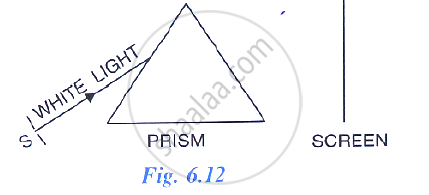Advertisements
Advertisements
प्रश्न
In following diagram shows a thin beam of white light from a source S striking on one face of a prism.

What conclusion do you draw from the observation in part (b) above?
उत्तर
From the observation, we conclude that prism itself produces no colour.
APPEARS IN
संबंधित प्रश्न
Why is the colour red used as a sign of danger?
How does the deviation produced by a triangular prism depend on the colours (or wavelengths) of light incident on it?
If a monochromatic beam of light undergoes minimum deviation through an equiangular prism, how does the beam pass through the prism, with respect to its base?
(i) Draw a diagram to show the splitting of white light by a prism into its constituent colour.
(ii) Draw another diagram to show how the colours of spectrum of white light can be combined
to give the effect of white light.
Light of different colours is deviated through different angles, by a prism. Explain the reason.
Explain, why quartz prism is required for obtaining the spectrum of ultra-violet light?
Draw a neat diagram to show the arrangement you would use to project a pure spectrum of white light on a screen.
Which colour of white light travels slowest, in glass?
Write the approximate wavelength for red light.
The wavelengths for the light of red and blue colours are nearly 7·8 × 10-7 m and 4·8 × 10-7 m respectively.
Which colour has greater speed in glass?
